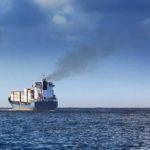Voyage Optimization Can Be Crucial in Reducing Shipping Emissions

AI and big data processing can help address one of shipping’s main problems today, i.e. emissions reduction through voyage optimization. In an exclusive interview with Dr Konstantinos Kyriakopoulos, CEO and Co-Founder of DeepSea Technologies, Hellenic Shipping News Worldwide (www.hellenicshippingnews.com), discusses the technology advancements which can help reduce emission today.
Voyage optimization is widely regarded as a key tool towards reducing emissions and lowering costs. What are the main benefits?
The basic principle of voyage optimisation is that almost every voyage sailed today contains a degree of waste. Perhaps not a very large degree – up to 10% depending on the voyage – but that is still enough to transform a company’s bottom line and significantly boost a vessel’s CII rating. Why is this ‘margin of waste’ such a consistent feature of the industry? It’s because squeezing the last 10% efficiency out of a voyage is about precisely tailoring how it’s operated to the current set of conditions. To do that requires an incredibly accurate knowledge of how every individual vessel responds to every conceivable set of conditions, which nobody has by default.

Dr Konstantinos Kyriakopoulos, CEO and Co-Founder of DeepSea Technologies
How does the technology that DeepSea offers to the market work?
DeepSea solves this problem. We take data from individual vessels and use artificial intelligence to generate a +98%-accurate behaviour model. It accounts for all the factors you’d expect – wind, waves, draft, fouling – and can predict how much fuel the ship will consume at different potential speeds within encountered conditions. The model is completely unique and updated live, in real time, as things change. What it gives us is, for the first time ever, true predictability over vessel behaviour. In other words, a real data-driven foundation for the decisions we make.
The practical outcome is a custom-built speed (and, optionally, route) plan for every vessel and every voyage, which we communicate and monitor via our platform, Pythia.
What’s the expected cost per vessel? Does it vary by ship type/size?
We’re currently seeing a return-on-investment of around 15x. We know there’s a lot more potential there – our clients see better and better results as this approach gets embedded in their organisation. All deep-sea ships can benefit from this approach – the ROI is higher for larger vessels, but we’re seeing a massive net-benefit from this approach across the board.
How keen are owners to adopt these new technologies? Do you see more uptake from specific parts of the industry, compared to others?
It’s no surprise that different trading models lead to different incentives. Much of the industry suffers from the ‘split incentive’ problem that we all know well – the charterer pays for the fuel that the owner burns. So, the incentive to be more efficient lies squarely with the charterer, whilst the ability to implement it lies with the owner. And in a world where more efficient vessels still aren’t commanding bigger premiums in the market, it presents a substantial obstacle to the decarbonisation of the industry.
The companies that, therefore, really benefit from our solutions today are owner/operators – those with both the incentive to make changes, and the power to implement them. For this sector of the industry, these sorts of initiatives are a no-brainer.
What are the main barriers towards a wider adoption of AI and generally voyage optimization technologies?
Along with the issue of misaligned incentives mentioned above, I believe that there is a particular tendency in the shipping industry to reach for ‘trusty’ metal rather than ‘mysterious’ silicon. Shipping has always had to be immensely technically resilient – issues at sea can be very dangerous, and vessels can’t rely on any form of external support. They must solve their own problems. This naturally leads to a culture of “trust what you see”, and “what’s complex is dangerous” – a mindset which extends even to well-proven and non-critical systems. In some people’s view, AI (and algorithmic voyage optimisation) is at the other end of the spectrum – a ‘black box’ which they don’t understand. There is some truth in this, of course, but the only way shipping can face up to its current challenges is to fully embrace digitisation. A degree of technical autonomy may be lost on a vessel-by-vessel basis, but what will be gained is immeasurably more powerful.
Do you expect them to play a key role in the event of a future supply chain disruption?
It’s certain that our level of understanding of how vessels and ports really behave – and how they interact – is majorly lacking. In 2023, when our cars are beginning to drive themselves, most vessels are still reporting their key data to shore via a single email per day (full of manually entered figures that may bear scant resemblance to reality). By and large, the industry functions in a state of continuous ‘low-definition’, which can be seen in everything from the vagueness of charter parties to the way fuel levels are measured. Ultimately, we should have much more resilient and accurate models of how the shipping industry works – and AI is certainly one of the best tools humans have to crack that nut. The first step to this “high definition revolution” – which has immense financial and environmental benefits for shipping companies – is to start digitising our fleet at a much faster rate than we have until now.
Nikos Roussanoglou, Hellenic Shipping News Worldwide
Source link
